Make your own Ion Alcohol Fuel Stove – Half Ounce SLX 2 cups of water boil
Posted: June 30th, 2013 by: h2
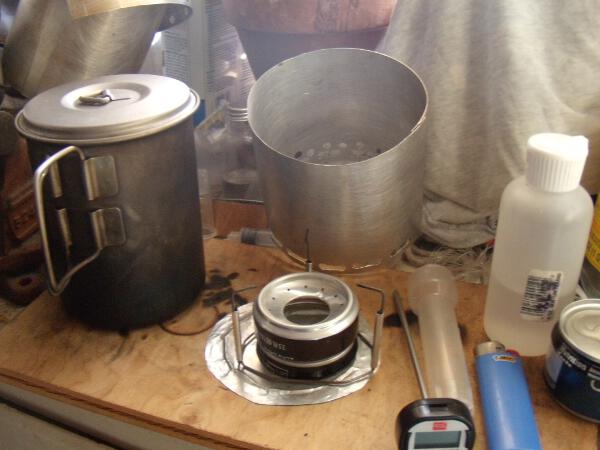
This is the setup I am using for these tests, screen, 2″ pot stand, 1.25″ tall stove, 4″ wind / heat screen, and a 900 ml Snowpeak titanium tall pot. I have also tested on a 600 ml stainless steel pot and that also works, though not quite as well as the ti pot. These are further references you can use to help you create and build the stove/screen/stand:
- Making your own Ion Stove
- Making a Pot Stand
- Reflectix Pot Cozy – coming
- Aluminum Flashing Wind/Heat Screen
- Fuel consumption for canister gas, alcohol, esbit, and white gas backpacking stoves
- Alcohol fuel efficiency for backpacking stoves – ethanol vs methanol
Note, see below for pot stand dimensions for Ion stove, the version linked to above is taller and wider, for a Penny large stove.
Thanks to Sgt. Rock for his Original Ion Designs and Tests
Before I say anything more, I want to thank Sgt Rock, the creator of the Ion stove for his assistance, and for his generosity with his time and knowledge, in finally cracking the .5 oz boil barrier. Everything here is based on his work, including some tips he gave me via email which proved to be absolutely critical, plus a few pointers that might not be totally obvious from his how-tos in terms of how to make the screens and pot stands and stoves.
Stove Design Goals
Here were my design goals as they evolved over some trips using a Mark Jurey Penny Stove, in several versions, with a few heights of wind/heat screens, 5″ to 6″. Because the penny stove has some advantages in terms of speed and wind resistance that the Ion stove may not have, I will do another how to on the penny stove at a later date, but this how to is going to be about how to create a realworld stove that has the following qualities:
- First, and foremost: must boil water using a narrow pot, using no more than 15ml fuel.
- Next, must boil using standard denatured alcohols like SLX, which you can find at any hardware store and even some larger supermarkets. This is also the fuel you are most likely to actually find hiking in the US in trail towns, so making this a requirement makes sense, particularly when sgt rock noted that this is what he achieved his legendary 12ml / 2 cups boil Ion with a .9 liter wide pot, which I will discuss a bit more in the conclusion.
- Stove must be easy to light, and require no priming. The penny stove is not that hard to light once you learn how to do it, but it’s a bit too finicky for my taste, too much priming, and you lose fuel as it flares up, too little, and you have to redo it.
- Screen / heat shield must be easy to use and fit inside of pot without any excessive gymnastics.
- Uses a pot stand. This is a very core requirement, because almost all stoves that require priming and pressurization from the pot set on top of it are not only not super stable, but waste heat while you wait for the stove to heat up. The penny does not have this issue.
- As a sub-requirement, and as an outcome of approaching the 15ml goal, fuel for a week, real cooking, on a real trip, should fit in an 8oz container, ie, small, compact.
- To repeat, must do all this using a narrow pot (ie, a pot that is taller than it is wide), 600ml to 900 ml.
- Must work out of the workshop, ie, outside, in various temperatures. See fuel efficiency thread appendix on altitude and boil times/temps / water temperature.
- Must nullify any claimed weight advantage of using a non renewable cannister stove with higher BTU gas as fuel source.
- Screen must be easy to store in pot, and must allow connecting each end to the other without extra steps or tools. I used to use bolts to hold it together with wing nuts, but it was too finicky for my taste.
- Stand must fold up for storage in the pot without taking up any real room
- Light weight. But that’s a given, it’s going to be light.
Sparing you the suspense, all of these goals are now met. Short version: pick one, efficiency or speed. (However, in a future post, I will give a how-to for the amazing CHS stove, which actually is quite close to the efficiency of the ION, but almost 2x faster to boil).
This set of requirements basically removes immediately all cone screen based stoves, all heat shields / screens that use bent edges to capture heat, and, conveniently, takes you right to sgt rock’s ground breaking work, which, oince you grasp the concepts involved, also creates a really good harmony of simplicity and efficiency that nothing else gets close to that I have seen, from anyone, anywhere. I have seen no side burners, or jet type stoves, that achieve this type of efficiency though I’m always open to learning more.
Testing Methods
- All tests are done with a real pot lid, which adds roughly 10% to boil efficiency by latest research I’ve read (latest edition of Cooks Magazine puts it at about 10% improvement in boil time, and they do good research).
- A digital thermoter is used to measure final and intermediate point temps. I do not have the kind you can leave in the pot, so you should get slightly better results without lifting the lid as often as I did.
- I consider at 160 ft above sea level a final temp of over 209F to be boiling because that is a visible rolling boil, and time to boil after that is counted from that point, since your food is cooking fine at that point. My latest screen tests show that increasing air flow at the base will raise the final temperature by a bit, and drop the time to boil temp, but I have not yet integrated this into a new screen design.
- Fuel is measured using a narrow home made graduated cylinder which is marked using a medical irrigation syringe, 10ml, this yields very accurate lines, the cylinder is marked to 2.5 ml quantities. If I get a real chemical graduated cylinder, my results may be updated very slightly, but these are quite accurate. Cups are measured using a measuring cup, 2 full cups, 16oz.
Making the Stove
Now I’ll walk you through the process of making the stove. Remember that you also need a pot stand and a wind screen, both of which are key parts of this system, and cannot be considered as a side thing of little importance. A pot cozy also is useful to help retain heat while letting dried foods rehydrate, or cook, after boiling.
For this stove, I decided to go with the 7.5 oz soda cans, which are easy to find, and have about the right size for this amount of fuel. For non USA readers, these cans are 54mm in diameter, and made out of fairly thin aluminum, not like the heavier type cans you find in for example energy drinks. I don’t believe the diameter is critical, my guess is +- 4 mm is safe (50-58mm diameter) and will not change the performance very much.
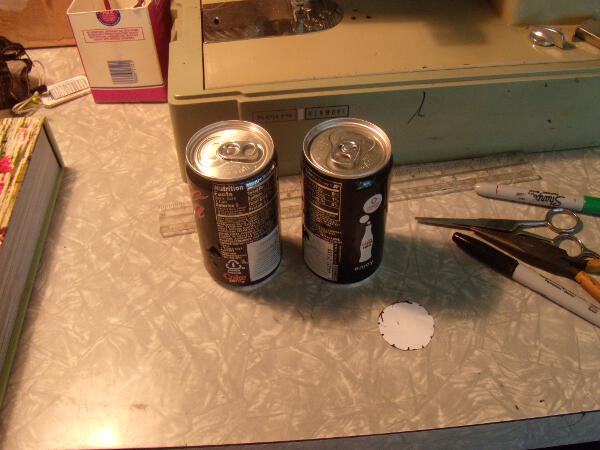
We need two cans, I picked coke zero because it’s a black can. I suggest not doing this, it’s hard to see the markings on them for the cuts, but it does look kind of cool. And no, I do not drink the soda, I dump it into the sink, I backpack for my health and to be around nature. Tip: you can keep the top almost intact by just barely cracking the top tab, just enough to let the stuff inside squirt out under pressure, in the sink. Once the pressure is released, cut a hole in the side to drain the can and rinse it out. If you drank it, you can push the tab back in to make the base later.
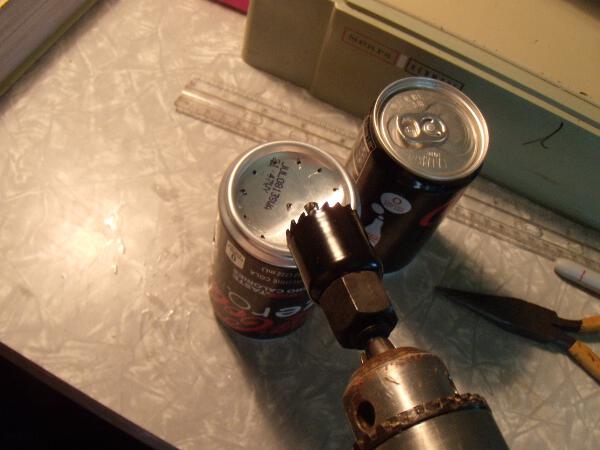
On the base of one, using a sharpie or something like it, mark the center hole at the bottom of the can, then, using a paper template, cut a circle that is 1.5″ in diameter, and mark 12 lines on the template (hint: you can use a compass to create the template, then use the compass to mark 6 divisions of the circumference, then divide those each in half, that gives you 12). The center hole will be 1″. You can either cheat, like I did on this stove, and use a 1″ specialized drill that works really well, or, with great patience, scribe the circle with a sharp blade, then punch it out.

There’s the finished can, note we did this while the can is intact, it’s easier to do that. So there’s a 1″ center hole, and 12 1/16″ holes. I used a 1/16″ inch drill bit, but if you did it carefully, you could use a large thumbtack, though it might be a bit smaller. The 12 holes will create a very cool result once the stove blooms fully, I didn’t believe it would work until I looked at one as it lit. Sgt rock also pointed this fact out.
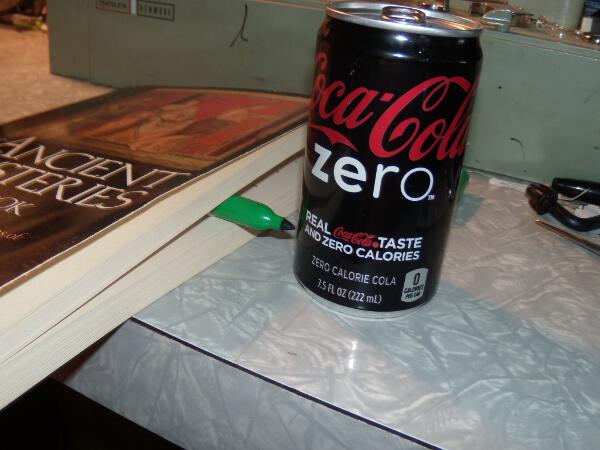
This is how you mark the cut lines on the can. Both cut lines on the can bottoms will be 3/4″. Just stick a sharpie in a book, then use a ruler to measure 3/4″ from surface of table to to the tip of the sharpie, adjust in book until it’s right. The can top is going to be about 3/8″ or so, but that varies depending on where the top curve hits the can sides.

This is where I wish I’d used lighter colored cans, red or silver, for this how-to, anyway, the can bottom has a line around it at 3/4″, the top has a line right around where the can starts to curve in, that will vary according to the brand of can so I won’t give a measurement.
The trick here is to start a cut about 1/4″ to 3/8″ above/below the marked line using a box cutter or sharp thin knife, then cut around the can using small scissors, but don’t try to match your marked lines, cut about 1/4″ outside of those lines, this makes the final trim much easier, trust me on this, and also gives you some leeway to make mistakes on the first rough cuts.
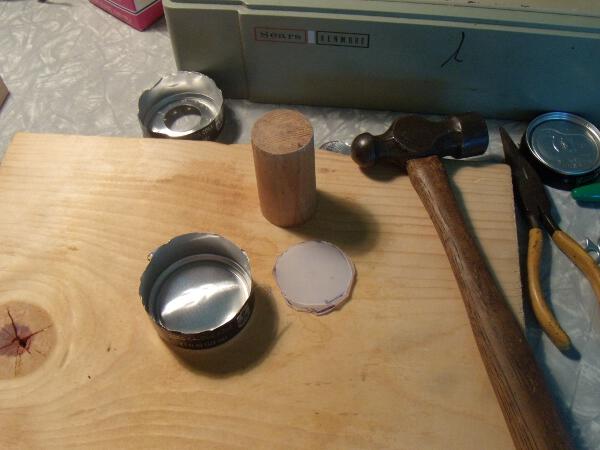
There’s the two parts, the top and the bottom. I cut some thin disks of plastic to help the next step, I put them under the base as I whack it with the wood block and hammer from the top, to keep it from going too far down. the next step is to pound down the dome of the bottom of the stove, that is, this increases capacity by a bit. Don’t pound it too far down because then it won’t fit into the base.

There you see the bottom, pounded somewhat flat, and now we’ll trim the rough can edges towards the marked line. Note, if you cut in at an angle you can easily get the line in a smooth motion, then just cut along the line until you get to the end. If you turn the can part around and trim it from the bottom it’s a bit easier to get any irregularities trimmed off once you have finished. The little disk with the hole in it comes from the special drill bit.
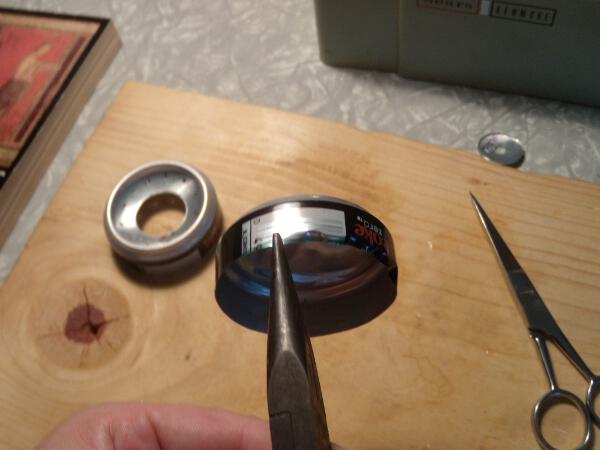
Both can parts are now trimmed, along with one of the can tops, which will form the base, you’ll see a picture of that in a bit. Take some narrow plyers and bend in about 1/4″ of the can bottom, this will let you insert it into the can top, which is the hardest part. I have heard some people say they can do this without bending one edge in, but I have no idea how they do it. Remember to sand the inside of the can where the holes were cut to remove any rough edges or aluminum pieces before you assemble the stove.
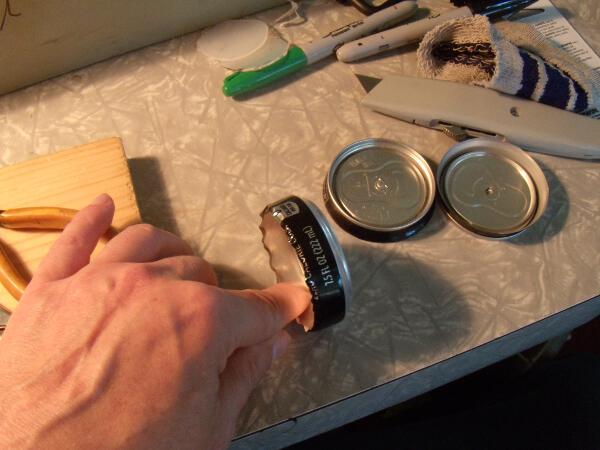
Take the can and push down any irregularities from bending in the inner part of the stove, by pushing down with your finger as you roll the can part around on a hard surface. Tile works well.
You can see the two can tops as well, one will form the base for the stove, which does two things, it insulates it from the ground, which keeps the alcohol from getting too cold, and it protects the ground from burning due to the heat of the alcohol. Notice that I removed the tab part, I do that by carefully cutting the tab where it has narrow part, right next to where it attaches to the top, then I take some needle nose plyers and carefully bend the part that is attached to the top back and forth until it comes off, then I give that a good whack with a hammer using the cylinder of wood under it to smooth out the top surface of what will be the base of the stove.

I couldn’t take pictures of the part where I insert the stove bottom, with the bent in edges, into the top part, because it’s tricky and you have to use two hands. If you fail on this project, this is where you’ll fail. Tip: stick the inner part, the bottom, with the bent in edges, on a tray of icecubes for a few minutes in the freezer, that will both shrink it a bit and also make it a bit slippier from the condensation moisture. Basically, you take the top and press it very carefully down on the bottom, then very carefully tap around the edge to get the parts to meet, the edge of the top should stop right about the start of the curved in part of the bottom.
Again, I’m sorry I don’t have pictures of this, because it’s by far the most critical part of the project, and the only part where you can expect to fail. Failing is failure to seal the two parts against each other. If you bend in at around 3/8″ instead of 1/4″ it will be slightly easier.
You have to take great care to press down the edges against each other so that the two parts basically go directly into each other, not at an angle.
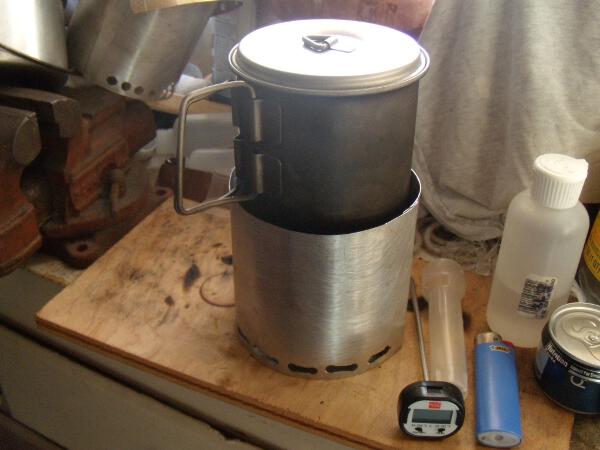
There’s the stove setup complete and ready to go. That’s a small inpointing jet penny stove to the right in case you’re wondering, which was the benchmark I was using, ie, it was what I was trying to beat in terms of efficiency.
Critical Points
- Pot stand should be about 5/8″ inch above top edge of stove, with stove base. This should be somewhere around 1 7/8″ and 2″ depending on how tall you made the base. For a narrow pot, you have to bend the stand a bit to round the base out, I use 3″ for each leg at the bottom, and 2.5 or a bit less for the height of each part of the stand for this particular stove. You can use this how to build a pot stand as a basic guide, just adjust the length of the base and the height fo the legs. For a cheap way to do it, get 0.055″ music wire from Ace Hardware hobby metals, and thin aluminum tubes that just barely fit two widths of the wire inside it. For bigger pots you want to go up to the next size of wire. That wire is very strong and stiff, by the way, but also very light.
Hint: go to a decent bike shop and buy 16 or 17 gauge stainless steel spokes, most good bike shops sell them individually. You will need 3. Go to Ace hardware hobby metal rack after and match two spokes to the aluminum tubes, two spokes per tube that is, stick them in to make sure it’s the right diameter, that is. If you want to really splurge, get titanium spokes, but they cost about $5 each, and the weight savings is actually non existent, 17 gauge stainless steel, or 16, will be lighter, and stronger.
- The most critical part of this project is the wind/heat screen. The dimensions are as follows: take diameter of pot, measure several times you have the true diameter, then add 0.5″ to that, so you will end up with a screen with a 1/4″ space between the screen and the pot. Measure this several times, then, using the formula diameter x pi, or 3.14, you get the basic circumference of the screen. Add 1.5″ inches to that to get the nice folded over joint for the two screen ends. Ace hardware sells 4″ aluminum flashing by the foot, most pots will not need more than that. Another good tip sgt rock gave was to make the screen in general no higher than the bottom of the handle of the pot. Basically that means about 4″ inches tall, since the pot stand is going to be about 1 7/8″ tall. You can also use the aluminum you get from the oven pans you can buy at stores, though they are not as solid as flashing. Note: the top lip of the pot is NOT the diameter in most pots, it sticks out a bit, so make sure to measure the outer diameter of the actual pot body. This is very important.
I will post a how to on the screen construction because that is a critical part, but the basic idea is simple: calculate circumference, add 1.5″ to that to allow for the 1/2 folded over ends that let you easily connect the two ends without any fuss or bother (like a flat felled seam, only done in aluminum, that is). The key for narrow pots, as I recently finally found out, is having enough square inches of air inlets, about 2.5″ square inches is about right. You can get this by marking all around the base of the screen 1″ marks, then 1/2″ marks between those, then cut out those with a hole punch, then join with scissors every other hole, forming slots, that let in just enough air. A 5/16″ hole based slot will work slightly better.
- Cut out a circle of aluminum from either a pie tin or a oven pan, make it about the same size as the screen when assembled. This serves two purposes, one, it’s a heat reflector, which will send up heat to the pot instead of absorbing it into the ground. It also further insulates the base of the stove, as well as keeping any stray fuel from starting a fire, which will of course lead to more bans of alcohol stoves as time progresses, so do try to be responsible and use these things safely.
Performance
Measure it decently well
Get yourself a reasonably accurate fuel measuring device, remember, nothing is more accurate than weighing the fuel, 1 fluid ounce of fuel, whether ethanol or methanol or half and half weighs close to .8 oz. 30ml, that is, weighs 24 grams.
You can get medicine measuring cups that are about 1 ounce in size and show markings for 20ml, 15ml, and 12.5 ml, and those are quite accurate. I have a bunch of those, so if you want one, I’ll mail you one for $1.50 sent to my paypal account. If there is any demand, I’ll add a small store to this site to handle such things, we’ll see.
You want to get an accurate measuring device to make sure you got the setup right, but anyone who follows these basic directions should be able to get SLX boils of 15ml to 14ml of 2 full cups of water without any further issues or headaches.
Wind and alcohol stoves
Wind is a major issue with alcohol stoves, and possibly even more with this stove/screen system, because the screen is both short and has air holes all around the base. You can deal with this issue in several ways, depending on how you like to do it, you can use your tent or tarp as a wind screen, you can use a foam pad if you use one as a bigger wind screen, you can use big rocks or trees as natural wind breaks, but whatever you do, get that thing out of the wind, it kills efficiency, and you will probably not get a full boil until you get it out of the wind!!
Setup and stove performance
Besides the wind issue, this stove/screen/pot stand setup is crazy easy to use and light and store, it takes almost no room in your pot, you can fuel it for over 1 week with 8 ounces of generic denatured alcohol like SLX. If you use ethanol type denatured alcohols you should get a 13ml boil with no problem at all, since it has about 25% more energy than methanol, slx is about 1/2 methanol, so a 10-15% increase in efficiency should be expected using high ethanol fuels like Kleanstrip Green. You can also mix 1/2 kleanstrip green with slx, to raise the ethanol content but get rid of the sooting issue with klean strip green.
The best results gave me a solid 2 minutes plus boil with 15ml fuel, reaching over 212F, but with a bit less air flow like you see in my current screen, with 1/4″ holes/slots, you get a bit weaker burn and a bit less heat. This thing needs air to work at maximum efficiency!
As I noted in the short version, pick one, efficiency of boil, or cooking/boil speed. Since the ion yields a 10 to 11 minute boil and is by far the most efficient, as well as easy to make, stove I’ve found, the roughly 3 minute differential in boil times to me is not worth the extra fuel consumption of a stove like the Penny stove, or the even less efficient, but very easy to make, Jim Wood Super Cat Alcohol Stove.
Fuel consumption/weight/volume
The idea of carrying a week’s worth of fuel in an 8oz bottle struck me as so appealing that it was just irresistable as a target to me, and it had to hit a very comfortable 15ml boil, not just barely, which the Ion achieves easily, ie, you don’t need to worry about running out due to failure to boil. Keep in mind that alcohols like these have a specific gravity of about 0.79, which means that 8 fluid ounces weighs about 6.4 ounces, so keep that in mind when comparing weights of gas canisters, it makes a big difference and is why a lot of the gas canister weight/over a week are false or incorrect, or at least misleading. 15ml of alcohol weighs about 12 grams, to remind you of this basic fact again. 1 ounce of alcohol, ie, what you would use for 2 meals, a day for most people, weighs .79 ounces, or 24 grams.
Air flow – Heat/Cold considerations
Hotter outside air results in more air required, I assume the colder it is outside, the less air holes are required, but testing will show this more readily. The time I am writing this air temps were around 80F, which forced me to re-evaluate the actual amount of air gap area was required in the screen. Not enough, and the air heats too much, which overheats the alcohol, which makes it boil off too fast, which makes it not burn completely, which drops the efficiency. Not that different, that is, from an engine with a fuel / air mixture, too lean, and it doesn’t burn hot enough, too rich, and it burns too rich, ie, incompletely, just like in a car. The temperature of the incoming air, and the volume, determines the richness of the burn, basically.
Weight
Ok, what would an ultralight stove posting be without the weights? Since the pot and the cozy are variables, as is the fuel container and measuring device, I’m just going to list the weights of the parts we made here:
Stove/base: 9.7 grams
Pot stand: 7.1 grams
Bottom heat reflector: 1.8 grams
Heat /wind screen: 25.2 gramsTotal: 44 grams, or 1.5oz or so. 1.5 ounce is a very good weight for just the burner unit of a canister stove, by the way, ignoring the steel canister weight, which basically nullifies the extra btus contained in the hydrocarbon gas canister stoves use.
A reflectix pot cozy weighs about 1 ounce, an 8 oz fuel bottle weighs 1 oz or so, your pot probably weighs 3.5 to 4 oz, give or take.
So a sample kit, with a few add ons like spoon, cup, fuel measure, and spices etc, will weigh under 10 oz realworld weight, including a real lid, which optimizes boil times and fuel consumption. Realworld is also known as trailhead weight, ie, the weight the thing actually weighs when you step onto the trail. This number is often quite different than what people list as ‘base weight’, by the way, and is always far more accurate, ie, pack up your cook kit and toss the entire thing on a scale right before it goes in your pack, that’s what your trailhead weight is. The only thing that doesn’t include is the weight of the fuel, that is, though that’s also actually your real trailhead weight. To find the trailreturn weight, simply weigh your pack and cook kit when you get back, that’s the actual base weight you were carrying, and is also far more accurate because it’s the weight on your back, not what your spreadsheet or whatever listed, heh.
Sgt. Rock Setup and 12ml Boils
While I have not tested yet on a wide ti pot like an evernew 1.3 liter, I can tell you that the results sgt rock achieved, a comfortable 12ml boil using SLX denatured alcohol, were reached using an evernew type .9 liter wide pot. The air holes you can see on his site appear to be about 3/8″ big, which yields a significantly better air flow than 1/4″ air holes. My arithmetic shows that to get the equivalent of lifting the screen off the ground by 3/16″, which yields by far the best boils of anything I tried, you need about 50 1/4″ air holes, but slots seem to work better, maybe less turbulence in incoming air, not sure.
He also does not use a base for the pot, and uses a ti stand that is made out of plating, which will create some differences in flame efficiency, but my tests with a aluminum flat screen like he uses showed no particular advantage, so I stuck with my easy to make and fold up pot stand, which is also very very light.
Using wide pots results in a few advantages in terms of maximum efficiency, the flame for example does not really go up the sides, and the burn chamber (the part between the pot bottom, heat reflector, and screen, is quite a bit bigger, allowing for cooler air in general, which is a critical part of getting maximum efficiency, the flames must both get enough air, and the air must keep the alcohol from boiling too fast, which results in too rapid vaporization of the fuel, and incomplete ignition, which results in failure to boil with 15ml or less. It took me a lot of testing to figure this out, a narrow pot is harder in general to get these excellent efficiencies, but, as I finally learned, it is possible with narrow pots as well, 14-15ml is easily achievable once you get the parts to integrate properly.
Conclusion: It Works! All Goals Reached!
As sgt rock pointed out to me, focus MORE on the screen and LESS on the stove, though his stove is a wonder to behold when it achieves its mushroom-like flame pattern, that’s what the 12 little holes are for in case you’re wondering. Air flow into the stove is critical, particularly for narrow pots, because there simply is not that much room around the circumference to add holes, slotting the holes however takes care of that last hurdle, and was the missing piece for me.
All goals achieved, easy to light, easy to get fuel for, using SLX, easy to setup screen, easy to store, and more efficient than anything I’ve tested, by far, at least to this point. Price, the cost of a few feet of flashing, 2 7.5 cans of soft drink, the tubing/wire from ace, if you don’t have it, total cost, about $4, but the tubing and wire will be enough for many stands.
While I used a lot of fuel over the last years, the results were worth it, I went from getting barely 2 cup boils with 17.5 or 20ml of ethanol, which is harder to find and more expensive, to consistent 15ml boils with SLX, which is easy to find and cheap, and is what you’d actually expect to find when resupplying anywhere, at worst.
So rather than wasting all that fuel in testing, here’s my results so you can duplicate the process without wasting all the materials and time to test and build all the different versions, start from this point, that is, and see if you can find a way to improve it even more, your comments are welcome, as is all advice and further tips.
- Pot stand should be about 5/8″ inch above top edge of stove, with stove base. This should be somewhere around 1 7/8″ and 2″ depending on how tall you made the base. For a narrow pot, you have to bend the stand a bit to round the base out, I use 3″ for each leg at the bottom, and 2.5 or a bit less for the height of each part of the stand for this particular stove. You can use this how to build a pot stand as a basic guide, just adjust the length of the base and the height fo the legs. For a cheap way to do it, get 0.055″ music wire from Ace Hardware hobby metals, and thin aluminum tubes that just barely fit two widths of the wire inside it. For bigger pots you want to go up to the next size of wire. That wire is very strong and stiff, by the way, but also very light.